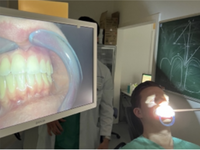
Recent developments in generative artificial intelligence (AI) offer a promising pathway for reducing long-standing administrative burdens for physicians and clinicians. Specifically, there is a rapidly evolving field of ambient AI scribe technologies that health care organizations and clinicians are adopting and that industry partners are keen to support. Professional societies and physician-run organizations are also engaging in the overall discourse, development, and use of such technologies. Promised improvements include a reduction in documentation time, restoration of valuable patient-clinician interaction benefits, efficiency and productivity enhancements, and overall improvement in the quality of patient care and satisfaction.
Although early studies have demonstrated promise in reducing the administrative burden, there are likely unintended consequences of such rapid adoption with limited scientific evaluation. Some physician professional societies advise caution on the use of ambient scribes in general practice, warning about the potential for privacy risks associated with the technology. Data and algorithmic biases, cognitive biases, and linguistic biases have unclear consequences for patient care quality, population health management, and overall patient and clinician experiences in health care settings. The impacts of the rapid adoption of ambient AI scribes on the training of health care professionals in health care settings where trainees are also a part of the work and learning environment are also unclear. Patient or caregiver involvement and experiences when receiving synchronous (ie, visits) or asynchronous (ie, via patient portals) care involving AI scribes also remains unexplored.
In this Call for Papers, JMIR Medical Informatics is interested in original research and evidence-based viewpoints, tutorials, and other article types that explore the rapidly growing field of ambient AI scribes and other forms of AI-driven documentation, such as voice technologies or ambient dictation and ambient listening tools, in clinical settings. Perspectives on these technologies in practice from clinicians, patients, and health care leaders are welcome. We are particularly interested in submissions that explore the practical applications, evaluations, challenges, and future directions of AI-driven or AI-facilitated clinical documentation in real-world clinical workflows.
JMIR Medical Informatics also has a related open Call for Papers specifically for industry partners who may wish to submit high-quality, rigorous implementation reports to the e-collection on Advancing Digital Health: Real-World Implementation and Strategic Insights from Industry-Driven Innovation. Papers from industry submitted to the current Call for Papers can also be considered for suitability to the e-collection.
Topics of Interest:
Submissions to this Call for Papers may explore, but are not limited to, the following topics:
Development or evaluation of novel architectures and algorithms for AI-driven documentation, for example, across different roles, specialties, or practice settings
Integration of AI scribes with health information systems, including electronic health records or patient portals
Evaluation of AI-driven documentation tools, including user interface/user experience (UI/UX) design; accuracy, quality, and clinical utility; patient safety and quality of care outcomes; or unintended consequences
Impact on clinician task load, efficiency, burnout, and well-being
Data privacy, security, and confidentiality in AI-driven documentation
International perspectives, policy issues, and regulatory frameworks for AI scribes
Medicolegal implications of using AI-driven documentation
Potential for bias propagation, detection, and mitigation due to AI-driven documentation
Impacts on the quality and experience of patient-clinician interactions (eg, patient trust, acceptance, and ethical concerns) as well as patient perspectives of AI scribe impact on patient-clinician encounters and access to or review of open notes
Strategies for successful integration and deployment in various clinical settings
Training and education programs for health care professionals on AI scribe use, for example, learner experiences and consequences with AI-driven documentation
Cost-effectiveness evaluations of AI scribes, for example, in facilitating health care services coding and billing
Climate impacts and social responsibilities of institutions and industry partners developing and adopting ambient AI technologies
Also read the related JMIR Medical Informatics editorial for more information [1].
How to Submit:
Please submit to JMIR Medical Informatics by selecting “Ambient AI Scribes and AI-Driven Documentation Technologies” in the “Section” drop-down list. See the articles How do I submit to a theme issue? and Instructions for Authors in our Knowledge Base for more information on how to submit a manuscript.
Submission Guidelines:
All submissions will undergo a rigorous peer-review process, and accepted articles will be published as part of the “Ambient AI Scribes and AI-Driven Documentation Technologies” e-collection. Standard APF applies.
Submissions not reviewed or accepted for publication in this JMIR Medical Informatics e-collection may be offered a cascading peer review or a transfer to other JMIR Publications journals, according to standard publisher policies. For example, early-stage formative work that informs the design of future interventions or research may better fit the scope for JMIR Formative Research. Authors are encouraged to submit study protocols or grant proposals to JMIR Research Protocols before data acquisition to preregister the study (for Registered Reports, subsequent acceptance in one of the JMIR Publications journals is guaranteed).
All articles submitted to this e-collection will be shared and published rapidly through the following mechanisms:
- All peer-reviewed articles in this e-collection will be immediately and permanently made open access. This is the standard for all titles within the JMIR Publications portfolio.
- Articles can be made immediately available in JMIR Preprints (with a DOI) after submission if authors select the preprint option to enable this service.
Submission deadline: December 1, 2025
Submit Now
Editors
Arriel Benis, PhD, FIAHSI
Associate Professor and Head of the Department of Digital Medical Technologies, Holon Institute of Technology, Israel
Andrew Coristine, PhD, MSc
Affiliate Faculty, Department of Medicine - Division of Cardiology, McGill University, Canada
Reference
- Leung TI, Coristine A, Benis A. AI Scribes in Health Care: Balancing Transformative Potential With Responsible Integration. JMIR Med Inform 2025;13:e80898. DOI: 10.2196/80898












